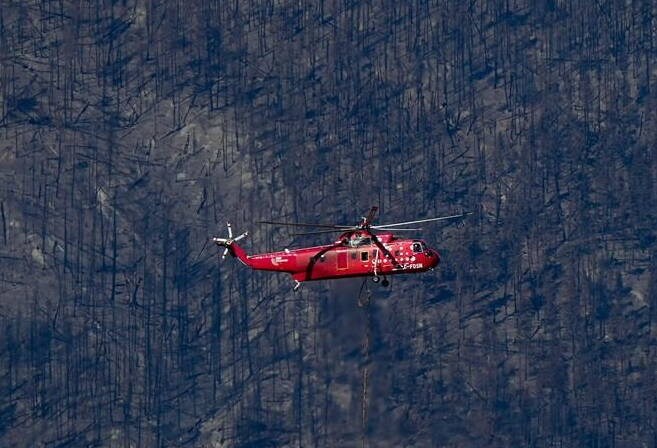The onset of large, severe wildfires that threaten communities year after year has occurred earlier in British Columbia than previous research projected, and experts say the record-shattering 2023 season must serve as a springboard for action.
The surge stems from a combination of climate change and entrenched forest management practices, which have together created a landscape more conducive to large, high-intensity blazes, says Lori Daniels, a professor in the department of forest and conservation sciences at the University of B.C.
“Society is already paying a huge cost for these climate change-fuelled fires,” she says.
“The thing we can control in the short term is the vulnerability of the landscape.”
Reducing that vulnerability means transforming how B.C.’s diverse landscape is managed. Shifting away from a timber-focused approach that prioritizes conifers over less-flammable broadleaf trees and ramping up prescribed burningare key steps toward protecting communities by supporting healthy, resilient forests, Daniels says.
“The sooner we do it, the better,” she adds.
Daniels is the co-author of a paper published by the peer-reviewed journal Nature that examined data from the last century and found an “abrupt” uptick in wildfire activity in B.C. corresponding with a warming and drying trend that began in the mid-2000s.
The province has experienced its four most severe wildfire seasons on record during the past seven years, in 2017, 2018, 2021 and 2023.
This season has smashed records for area burned in B.C. and Canada, with wildfires scorching more than 165,000 square kilometres across the country.
The paper published last week notes wildfires scorched more than 10,000 square kilometres of land in B.C. during three of the past seven seasons. Between 1919 and 2016, just three years saw more than 5,000 square kilometres.
The surge in large, intense wildfires is not surprising given climate projections for the province over the coming decades, says Marc-André Parisien, a research scientist with the Canadian Forest Service based in Edmonton who led the study.
However, both researchers say it came sooner than expected.
“According to a lot of projections, in 20, 30 years is where you would have seen a real amplification of these fire regimes, but (it happened) around the turn of the millennium, so a fair bit earlier,” Parisien said.
Daniels says she previously thought the next generation of fire ecologists, not hers, would have to contend with the “new reality” of high-intensity wildfires.
“To have four of these seasons out of the last seven is shocking,” she says.
As communities expand farther into the wildland-urban interface, where forests meet human development, the paper shows summers in B.C. are increasingly characterized by hot, dry and windy conditions that are primed for wildfire to burn with speed and intensity that would almost certainly overwhelm suppression efforts.
Parisien underscores the significance of fire intensity.
“If a fire comes in rolling as a 30-metre wall of flames, there’s not a lot you can do,” he says. “You can dump a lot of water on it, but it amounts to spitting on a campfire.”
The researchers say climate change is not the only culprit, though.
The warming and drying trend that began in the mid-2000s coincided with pine beetle outbreaks that left swaths of B.C.’s forests dead, dry, brittle and ripe for wildfire.
The outbreaks also prompted the B.C. government to approve extensive clear-cut harvesting to salvage the economic value of the beetle-killed timber.
After logging, Daniels says the predominant approach in B.C. is to replant coniferous trees intended to feed the forest industry.
It’s also common practice to remove broadleaf or hardwood trees, she says, sometimes using glyphosate, the main ingredient in the herbicide Roundup.
“We have this kind of old dogma in forestry that the broadleaf trees only slow down the growth of the needle-leaf trees so we don’t want them there,” she says.
Yet broadleaf forests do not burn as intensely as their coniferous counterparts.
“If we can have patches of broadleaf forest and if we actively manage to maintain those to create fire breaks … we can actually reconfigure our landscapes to be more resilient to climate change and more resistant to these very large fires,” Daniels says.
Wildfire can be healthy for the landscape. It consumes dead leaves, branches and other fuels that build up and stoke high-intensity blazes, she explains.
Yet aggressive fire suppression that ramped up in the latter half of the 20th century has also led to what the researchers call a “fire deficit” in B.C., especially in forests and grasslands that are near communities with homes and infrastructure to protect.
Data from the provincial wildfire service shows more than 90 per cent of fires between the 1970s and the early 2000s were detected and suppressed before they reached four hectares in size, underscoring the extent of the strategy, Daniels says.
With the global climate heating up, Daniels says it’s critical for governments at all levels to work together to transform how B.C.’s diverse landscape is managed.
“That’s where we can take immediate action.”
Climate projections “give us forewarning of what is coming,” she says.
“This summer will repeat in the future, not only in B.C. but likely across Canada.”
Forests Minister Bruce Ralston says he’s optimistic that a new system of forest landscape planning introduced two years ago will usher a “new era” of forest management that includes wildfire resilience once it’s expanded across the province.
Rather than focus on timber alone, the new process aims to consider a range of values, including biodiversity, ecosystem health and community participation, Ralston told a press conference related to wildfire and drought last week.
Parisien says the 2023 wildfire season is likely to be a “game-changer” in Canada.
“There’s going to be lots of conversations that may lead to some really creative and original ways to manage the land,” he says.
“To really deal with this wildfire problem, with the new climatic context, you really need to take the bull by the horns.”
This report by The Canadian Press was first published Sept. 10, 2023.



